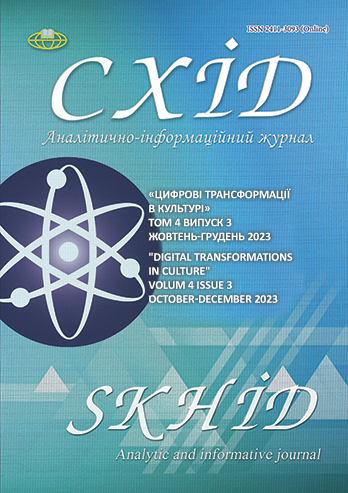Artificial intelligence and digital art: current state and development prospects
DOI:
https://doi.org/10.21847/2411-3093.2023.4(3).294658Keywords:
artificial intelligence, digital art, Neural networks, creativity, computer aestheticAbstract
The article analyzes the use of artificial intelligence in various types of digital art at the current level of their development and outlines the possibilities of external ways of such interaction. The author considers specific artistic examples, which see that the use of artificial intelligence in art develops a complex art history and philo-sophical questions: what is art? how does computer technology change aesthetics? where is the line between technology and creativity? who is considered the author of the work generated by neuronets? is it possible to compare anthropocentric and non-anthropocentric forms of creativity? etc. The researcher demonstrates different approaches to the chosen topic, citing antagonistic points of view of scientists. Some of them believe that art with the help of a computer is the next step in the development of avant-garde trends, while others see these trends as the degradation and even the death of art. In digital painting, we are already faced with the use of works (the most famous example is the android-artist Ai-Da) who know how to draw in different techniques and with the use of different tools. The victory of a painting generated by a neural network at an art competition raised questions about its au-thorship and the admissibility of participation of such works in competitions for art-ists. Discussions on the ArtStation platform indicate that many artists do not per-ceive works made with the help of artificial intelligence as "real" works of art. In mu-sic today, it is possible not just to generate melodies, but to create an imitation of certain styles or composers, which raises questions about the nature of true creativi-ty and its limits. Another direction of using artificial intelligence in music is the crea-tion of virtual singers who become mega-popular. Such an example is given by the Japanese virtual singer Hatsune Miku, who is a hologram with an android interface and an artificially generated voice. In the field of video games, artificial intelligence knows how to create not only levels, but already generate game target worlds and complete games. Artificial intelligence in photography can generate images of non-existent people. At the same time, it is unlikely that artificial intelligence can com-pletely replace a human artist, after which he learns from the previously created ma-terial. This makes it possible to say that he left real creativity and knows how to compile in advance, and not to generate original artistic solutions.
Downloads
References
Brown, M. (2021). ‘Some people feel threatened: face to face with Ai-Da the robot artist. The Guardian. 18 May. Retrieved from https://www.theguardian.com/culture-/2021/may/18/some-people-feel-threatened-face-to-face-with-ai-da-the-robot-artist
Chibalashvili, A. (2021). Shtuchnyi intelekt u mystetskykh praktykakh. Contemporary Art, (17), 41–50. https://doi.org/10.31500/2309-8813.17.2021.248425 (In Ukrainian)
Goenaga, M. A. (2020). A Critique of Contemporary Artigicial Intelligence Art: Who is Edmond Belamy. AusArt, 8 (1), 51-66.
Guga, J. (2015). Virtual Idol Hatsune Miku: New Auratic Experience of the Performer as a Collaborative Plat-form. Arts and Technology. Springer International Publishing. Retrieved from https://www.academia.edu/9431519/Virtual_Idol_Hatsune_Mi-ku_New_Auratic_Experience_of_the_Performer_as_a_Collaborative_Platform.
Hardabkhadze, I. A. (2019). Tendentsii rozvytku dyzainu doby postindustrialnoho suspilstva. Bulletin of KNUKiM. Series in Arts, 41, 176‒184. https://doi.org/10.31866/2410-1176.41.2019.188689
Keen, A. (2007). The Cult of the Amateur: How Today's Internet Is Killing Our Culture. NY.: Doubleday. 242 р.
Osmuk, B., Skril, I. (2023). Shtuchnyi intelekt i tvorchist: rol shtuchnoho intelektu v heneratsii muzyky, mystetstva ta literatury Nauka i tekhnika sohodni. № 9 (23). S. 500-510. https://doi.org/10.52058/2786-6025-2023-9(23)-500-510 (In Ukrainian)
Popper, F. (2007). From Technological to Virtual Art. Cambridge-London: MIT Press (Leonardo). 471 р.
Romaniuk, O. N., Koriahina, D. A. (2022). Vykorystannia shtuchnoho intelektu v ihrakh. In: “Youth in science: research, problems, prospects”: Conference Papers. Vinnytsia Vinnytsia National Technical University. https://ir.lib.vntu.edu.ua/bitstream/handle/123456789/35633/%D0%9A%D0%BE%D1%80%D1%8F%D0%B3%D1%96%D0%BD%D0%B0.pdf?sequence=1&isAllowed=y. (In Ukrainian)
Rush, M. (2005). New Media in Art. London: Thames & Hudson. 250 р.
Singh, A., Tholia, S. (2023). The future of intelligent images: from simulation to stimulation. AI & Soc https://doi.org/10.1007/s00146-023-01664-7
Volynets, V. (2023). Vplyv shtuchnoho intelekta na suchasne mystetstvo: mozhlyvosti ta vyklyky. Tsyfrova platforma: informatsiini tekhnolohii v sotsiokulturnii sferi, 6(1), 21-31, https://doi.org/10.31866/2617-796X.6.1.2023.283933 (In Ukrainian).
Downloads
Published
How to Cite
Issue
Section
License
Copyright (c) 2023 Марія Чікарькова

This work is licensed under a Creative Commons Attribution-NonCommercial-NoDerivatives 4.0 International License.
1. Authors bear responsibility for the accuracy of facts, quotations, numbers and names used.
2. Manuscripts are not sent back.
3. The publisher does not always agree with the authors' opinion.
4. The authors reserve the right to authorship of the work and pass the first publication right of this work to the journal under the terms of a Creative Commons Attribution-NonCommercial-NoDerivatives 4.0 International License. This license allows others to distribute (copy) the published work for non-commercial purposes, provided there is mandatory attribution to its authors and a link to the first publication in our journal.
5. The authors have the right to conclude separate supplement agreements that relate to non-exclusive work distribution in the form in which it has been published by the journal (for example, to upload the work to the online storage of the journal or publish it as part of a monograph), provided that the reference to the first publication of the work in this journal is included.

